Display of works by the 20th century's two most prominent artists is a major attraction, Zhang Kun reports in Shanghai.
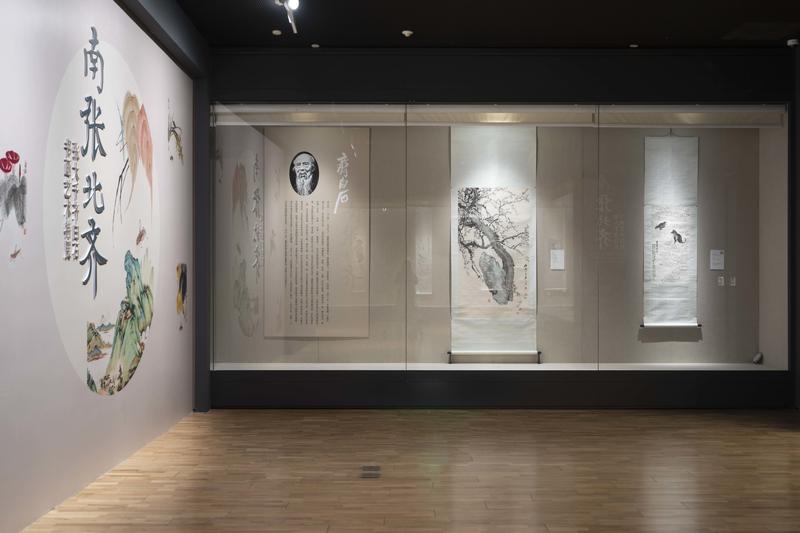 Artwork on display at the Southern Zhang and Northern Qi exhibition at the Long Museum in Shanghai. (PHOTO PROVIDED TO CHINA DAILY)
Artwork on display at the Southern Zhang and Northern Qi exhibition at the Long Museum in Shanghai. (PHOTO PROVIDED TO CHINA DAILY)
An unprecedented joint exhibition on the works of two prominent Chinese artists of the 20th century — Zhang Daqian (1899-1983) and Qi Baishi (1864-1957) — is now on at the Long Museum in Shanghai.
The exhibition, entitled Southern Zhang and Northern Qi, features 50 artworks by the two modern masters. Jointly presented by the Long Museum in Shanghai and Beijing-based art firm Rong Bao Zhai, the exhibition will run through to Oct 16 in Shanghai and then at the Rong Bao Zhai Art Gallery in Beijing.
Rong Bao Zhai is celebrating its 350th anniversary while the Long Museum in Shanghai marks its first decade this year.
Liu Yiqian, co-founder of the Long Museum, visited Rong Bao Zhai in 2020, when the two institutions decided to collaborate on the joint exhibition and display together, from their respective collections, the artworks of Zhang and Qi.
The institutions have selected "outstanding creations from different phases in the lives of the two artists, aiming to show their respective creative profiles in the early, midlife and late periods", Liu says.
Qi and Zhang are considered two of the most renowned ink artists in China.
 Autumn Flowers, ink and color on paper, by modern Chinese painter Qi Baishi in 1944. (PHOTO PROVIDED TO CHINA DAILY)
Autumn Flowers, ink and color on paper, by modern Chinese painter Qi Baishi in 1944. (PHOTO PROVIDED TO CHINA DAILY)
Qi was a native of Hunan province and moved to Beijing in 1919, where his art went through major evolution and his style became mature and established. He painted from nature and boldly borrowed from the methods of Chinese calligraphy and depicted everyday objects such as wild plants, insects and fruit with simple and summarizing strokes, developing his distinctive philosophical ideas about art and creation, according to Xie Xiaodong, curator of the show.
Qi's style echoed the minimalism trend of the global art scene.
Rong Bao Zhai, as an important art dealer in Beijing, worked with Qi, promoting his art during his lifetime. Qi also played an important role in developing the art firm's traditional woodblock printing techniques.
"Thanks to the close ties between Rong Bao Zhai and the artist, built in the long period of collaboration, we managed to accumulate a large number of outstanding artworks by Qi in the past century," said Zhao Dong, Party secretary of Rong Bao Zhai, at the exhibition's opening ceremony in Shanghai in September.
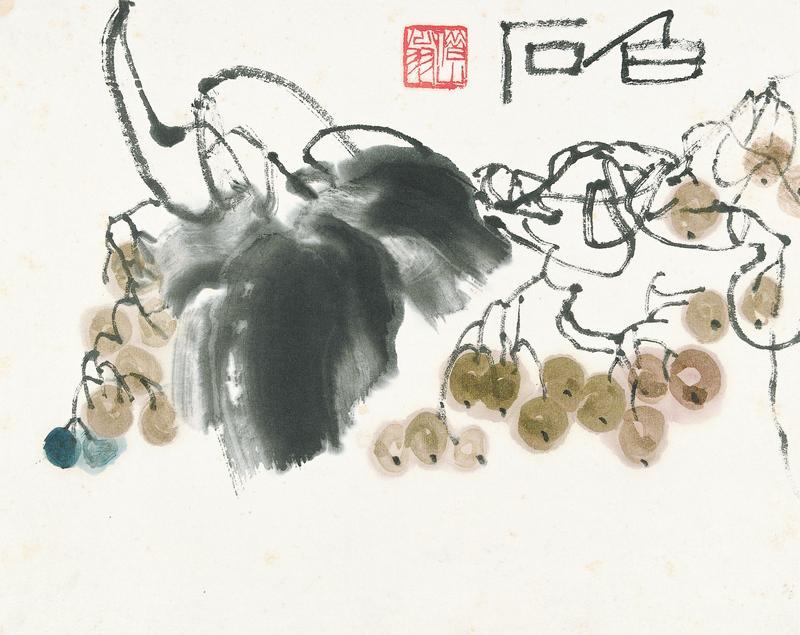 A painting of fruit by Qi from the collection of Beijing-based art firm Rong Bao Zhai. (PHOTO PROVIDED TO CHINA DAILY)
A painting of fruit by Qi from the collection of Beijing-based art firm Rong Bao Zhai. (PHOTO PROVIDED TO CHINA DAILY)
Long Museum is a private institution founded in 2012 by Liu and his wife, Wang Wei, who have been ardent art collectors for more than 30 years. In the past decade, the museum has built a comprehensive and systematic collection of Chinese and international art, and it is recognized as an important art institution not just in Shanghai but all over China, Zhao says.
"The art circle in China holds the Long Museum in high regard, and Rong Bao Zhai is honored to collaborate with it on the joint exhibition. Together we are presenting one of the most anticipated events in the Chinese art scene this year. The art communities in Beijing and Shanghai should communicate and work together more often," he adds.
Zhang is one of Liu's favorite artists. "I try to participate in the bidding process whenever outstanding pieces by Zhang emerge on the market, and through the years, I have managed to collect his paintings representing almost every major period of his creative career," he says.
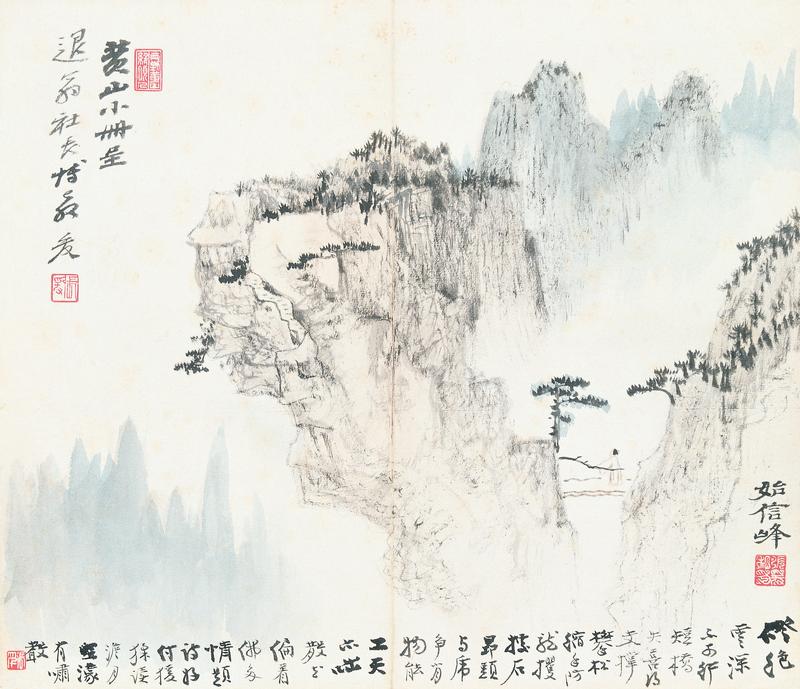 Mount Huangshan, ink and color on paper, by 20th century master Zhang Daqian. (PHOTO PROVIDED TO CHINA DAILY)
Mount Huangshan, ink and color on paper, by 20th century master Zhang Daqian. (PHOTO PROVIDED TO CHINA DAILY)
Half of the artworks on show are from Rong Bao Zhai and the other half from the Long Museum, with both stating that they are presenting a carefully selected collection of the finest, most representative and important creations by the two artists.
A significant part of the artworks is being shown to the public for the first time, Liu says.
Zhang was from Neijiang, Southwest China's Sichuan province, and became known at a young age for his capability in replicating classical Chinese artworks. In the 1920s, he became active in the cultural scene in Beijing, where he was recognized as a representative artist of southern China.
Zhang left the Chinese mainland in the 1950s, and lived in Argentina, Brazil and the United States before returning to China, settling in Taiwan in 1978. He ingeniously combined Chinese painting styles and methods of different periods, according to Xie, the curator.
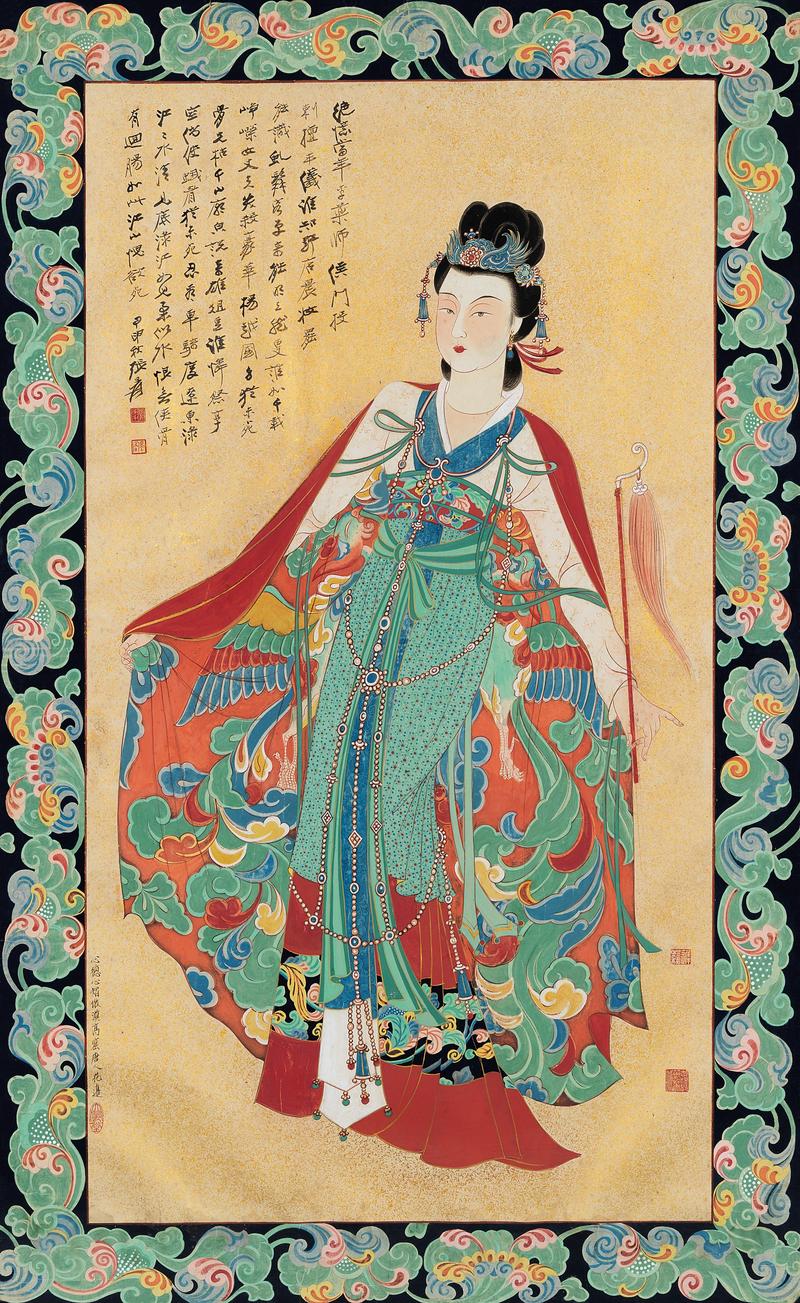 A portrait of Hongfu, a legendary woman in Tang Dynasty (618-907) folklore. It was painted by Zhang in 1944 in the fresco style of the Mogao Caves, in Dunhuang, Gansu province. (PHOTO PROVIDED TO CHINA DAILY)
A portrait of Hongfu, a legendary woman in Tang Dynasty (618-907) folklore. It was painted by Zhang in 1944 in the fresco style of the Mogao Caves, in Dunhuang, Gansu province. (PHOTO PROVIDED TO CHINA DAILY)
Inspired by traditional Chinese methods, he created landscape paintings by "splashing" ink and color onto rice paper. This technique is known as pocai. His paintings became an integrated and unique chapter in the global trend of abstract art. Today, he is known as one of the most important Chinese artists of the 20th century.
In the 1930s, both Qi and Zhang were active in the art scene in Beijing, and were often highlighted in exhibitions and media. Zhang used to visit Qi when he was in Beijing, and during his last visit in 1948, Qi accepted Zhang's wife, Xu Wenbo, as his disciple and created a painting for her as a gift.
Afterward Zhang moved abroad and gained a reputation in the international art world. In the meantime, Qi became recognized by the country as an "artist of the people" and began to occupy a prominent position in modern Chinese art history.
While they took different paths in their careers, Qi and Zhang both represent the exploration of Chinese art development in the modern age, reflecting "how an ancient civilization could creatively refresh its tradition to adapt to the new times", Xie says.
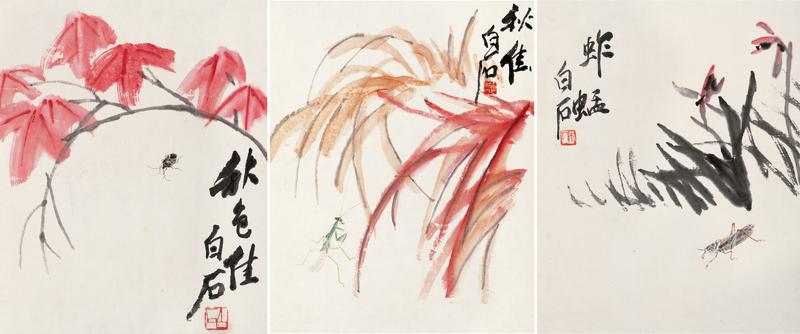 Three ink and color paintings on paper from the collection Flowers and Insects by Qi Baishi. His style echoed the minimalism trend of the global art scene. (PHOTO PROVIDED TO CHINA DAILY)
Three ink and color paintings on paper from the collection Flowers and Insects by Qi Baishi. His style echoed the minimalism trend of the global art scene. (PHOTO PROVIDED TO CHINA DAILY)
The current exhibition will help today's audiences to reexamine the time of the two masters and reevaluate their contribution by way of creativity.
"I believe this will be an enlightening discovery as we talk about Chinese ink art, as well as contemporary art, in today's global context," Xie adds.
If you go
Southern Zhang and Northern Qi — Exhibition on Zhang Daqian and Qi Baishi
10 am-6 pm (last entry 5 pm), Tuesday-Thursday, 10 am-8:30 pm (last entry 7:30 pm), Friday-Sunday, Sept 2-Oct 16. Long Museum (West Bund) Gallery 5, No 3398, Longteng Avenue, Xuhui district, Shanghai. 021-6422-7636.
Contact the writer at zhangkun@chinadaily.com.cn


